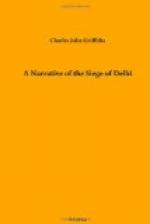The walls surrounding Delhi were seven miles in circumference, flanked at intervals by strong bastions, on which the enemy had mounted the largest guns and mortars, procured from the arsenal. Munitions of war they had in abundance—enough to last them, at the present rate of firing, for nearly three years. Long we gazed, fascinated at the scene before us. A dead silence had reigned for some time, when we were awakened from our dreams by the whiz and hissing of a shell fired by the enemy. It fell close below the tower and burst without doing any harm; but some jets of smoke appeared on the bastions of the city, and shells and round-shot fired at the ridge along the crest of which a small body of our men was moving. The cannonade lasted for some time, our own guns replying at intervals. We could plainly see the dark forms of the rebel artillerymen, stripped to the waist, sponging and firing with great rapidity, their shot being chiefly directed at the three other buildings on the ridge—namely, the Observatory—the Mosque, as it was called—and, on the extreme right, Hindoo Rao’s house.
From the Flagstaff Tower the ridge trended in a southerly direction towards those buildings, approaching gradually nearer and nearer to the city, till at Hindoo Rao’s house it was distant about 1,200 yards from the walls.
To the rear of this ridge, and some distance below, so that all view of Delhi was quite shut out from it, was the camp of the besieging army, numbering at this period about 6,000 men. The tents were pitched at regular intervals behind the ruined houses of the old cantonment, which, at the outbreak on May 11, had been burnt and destroyed by the sepoys. A canal which supplied us with water from the Jumna ran round the ridge past the suburb of Kishenganj into the city, and was crossed by two bridges, over which communication with the country to the north-west, and leading to the Punjab, was kept open by the loyal Sikh chieftains and their retainers.
Our position on the ridge extended about a mile and a half, the right and left front flanks defended by outlying advanced pickets, which I shall hereafter describe.
The city walls, as before recorded, were seven miles in circumference, so that at this time, and, in fact, almost to the end of the siege, we, with our small force, in a manner only commanded a small part of the city. The bridge of boats remained to the last in the possession of the enemy, and was quite out of range even from our advanced approaches, while to the right and rear of the city the gates gave full ingress to reinforcing bodies of insurgents from the south, whose entrance we were unable to prevent.




